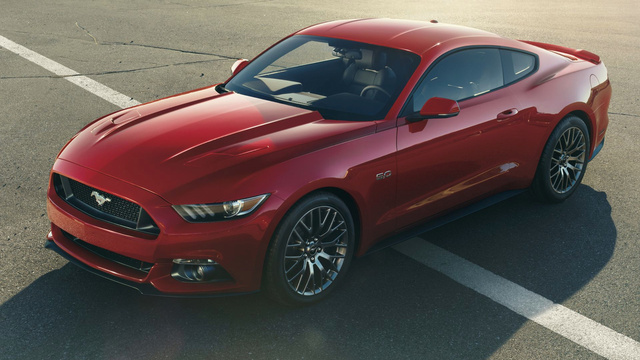Search the Community
Showing results for tags 'muscle car'.
-
Not so cool on the look of the real profile though... Still I hope it will come to our shores http://jalopnik.com/the-2015-ford-mustang-is-the-most-advanced-muscle-car-e-1476612775
- 186 replies
-
- 8
-

-
This beast is the 797bhp Dodge Challenger Hellcat Redeyehttps://www.topgear.com/car-news/usa/beast-797bhp-dodge-challenger-hellcat-redeye Good news, fans of gratuitously powerful under-tyred muscle cars. Dodge has updated the Challenger Hellcat for 2019, and introduced a new model that borrows bits of engine from the certifiable Demon. This is the Redeye. No, it doesn’t have glaucoma. What it has is the Demon’s the 2.7-litre belt-driven supercharger (the largest fitted to any production car), twin dual-stage fuel pumps, strengthened pistons and connecting rods among other things. Thanks to those modifications, the Hellcat Redeye’s 6.2-litre V8 produces 797bhp – 90 more than a regular Hellcat did when it came out in 2014/15. Torque is up by 57lb ft to an entirely appropriate 707lb ft. Available in standard or ‘Widebody’ (pictured) configurations (wider tyres and arches), the Redeye isn’t a replacement for the standard Hellcat. You can still buy one of those. Nowadays its makes 717bhp, which is still plenty, and will hit 199mph. The Redeye will do 203mph, hit 60mph in 3.4 seconds and trim a tenth from your ¼ mile time (11.1 for the Redeye, to 11.2 for the ‘standard’ car). Widebodys are a bit slower, but look roughly eight-point-three times cooler. The Redeye is only available with the eight-speed auto ‘box, however, whereas the standard car can be specified with a manual. Is that a deal-breaker?
- 4 replies
-
- dodge
- challenger
-
(and 4 more)
Tagged with:
-
If you are into muscle cars, chances are you love racing (or watching races) on a drag strip. Most folks who hang out at the drag strip will tell you that you will need some heat in your tyres to get the tyres to hook up better. So Ford came up with its latest feature, the 'electronic line-lock' to assist the driver in doing burnouts. You may think that burnouts are easy to do but modulating the brakes while letting the driven wheels spin up on the spot is tougher than you imagine (in manual transmission of course). But with Ford Mustang GT's line-lock, all you need to do is to throttle hard. The car will apply brakes on the front wheels only while the rear tyres are free to spin. http://dai.ly/x1r024o_introducing-line-lock-for-the-2015-ford-mustang-gt_auto For those who still like to DIY, you will be glad that this assist can be turned off.
-
The late Neil Armstrong was a very famous man due to him being the first man to walk on the moon in 1969. Astronauts of that time were on the same level as celebrities. And in order to drum up sales, a Chevrolet dealer (Rathmann Chevrolet) in Florida tried to get as many astronauts as they could to drive one of their cars. Astronauts were given a special lease to allow them to trade in for a new Corvette every year and in 1967, Armstrong got a blue Chevrolet Corvette that came with a 390bhp V8 engine and mated to a four speed transmission. The following year, he traded it for a 1968 model and the 1967 Corvette was sold to a NASA employee who has owned the car for 44 years. The car has not been started since September 1981 and the owner has mentioned that he kept the car in a climate controlled area. Over the years, the owner has added fender flares and aftermarket wheels to it. Additionally, the carburettor, water pump and exhaust system has also been replaced. The owner has offered the car for sale at this current condition and a Corvette restorer has bought it. Joe Crosby, the man who bought the car, has mentioned that it will not go through a restoration due to its historical significance. He stated that once a car has been restored, it can
-
- famous cars
- armstrong corvette
- (and 10 more)
-

What qualifies as a muscle car and the beginning of it
FaezClutchless posted a blog entry in MyAutoBlog
Many of us know what a muscle car is. But do we really know the factors that place a certain car in the muscle car category? Initially I thought that I knew so much about muscle cars but after reading a certain book about these cars, I became more knowledgeable and some of the so called facts that I previously thought were true are actually not. And now I would like to share them with you. 1965 Pontiac GTO convertible There are many varying opinions on what qualifies as a muscle car but before I touch on that let us see what does not qualify as a muscle car. First of all, it is not a piece of Italian exotic, Ferrari, Lamborghini, etc, nor it is a German performance car (Porsche, etc.). Even a British make sports car would not fit the bill (although there were muscle cars from other countries later on). All the abovementioned cars are too complex, specialised or efficient. Sports cars are not really considered as a muscle car. So, what really qualifies as a muscle car? It is essentially a North American phenomenon; in other words, in the beginning, it should be American made. The basic concept of a muscle car is taking a mid-sized American 2-door car and put in a large displacement V8 engine. The car itself should not be complex, upmarket or fancy. And usually, it should have a rear seating arrangement. 1966 Dodge Charger The muscle car concept is as simple as that. Furthermore in the beginning, the people who are interested in muscle cars are usually young and men. They are not interested in technical sophistication, excellent handling and even top speed. 1970 Dodge Challenger To the American youth of that time who were raised on drag racing, traffic lights street racing and hot-rodding, the most important factors to them were the size of the engine, horsepower and acceleration. In other words, all that they care about is straight line speed. 1958 Ford Thunderbird And when the big 3 American car manufacturers realised about this increasing trend among the youth, the companies started a power race to offer big engine displacements, huge horsepower and lesser seconds over the standing quarter. 1957 Chrysler 300C Before the era of muscle cars, the usage of V8 engines was already pretty rife during the 1950s. Companies like Ford and Chrysler all had their cars fitted with their V8 engines, for example the Ford Thunderbird and Chrysler 300. Their size were too big to place them in the muscle car category. Anyway, at that time the term muscle car has not been known or created. 1967 Chevrolet Camaro Although at that time these cars were not considered as muscle cars but they had one thing in common; they were built for powerful performance and this is one of the factors that the American youth of that time desired for a mid-sized, lighter-shelled car with big, powerful engines. 1969 Chevrolet Chevelle Conventionally, many would say or argue that the 1965 Pontiac GTO (top most picture) was the first true muscle car. 2-door mid-sized American car, huge V8 engine and it sits four people; all fits into the muscle car category. It also began a new car class that offered an affordable and stunning performance package. 1964 Ford Mustang The plan and idea for the GTO nearly did not happen. It came about when in 1963, General Motors would not produce overtly sporty cars and Pontiac was restricted with a standard 300 cu inch (4.8 litre) engine for their intermediate sized cars. And this upset some of their managers and engineers as Pontiac has always been a performance car marque and these same people are also fans of fast cars. 1968 Ford Torino GT FastBack These same people (one of them was John DeLorean who founded the DeLorean company) also felt that the only way to sell cars was by producing image-building cars and eventually the GTO plan went ahead. Before I continue, let me add that GM made all sorts of parts (engine, chassis, etc.) for NASCAR racing and they were road legal at that time. These parts were, at times, used for their production models. Pontiac fitted a 6.375 litre V8 engine together with a mix-and-match of existing parts and assembled them on the production line. This resulted in the GTO, made for truly affordable performance and the GTO fits into the muscle car concept, huge V8 engine in a smaller-sized car and it also started the trend. Other automakers soon followed with their own versions of this new car trend. Ford had its Mustang and Torino models, Dodge came out with the Charger and Challenger and Chevy had its Camaro and Chevelle models. Some people would argue that some of the models I mentioned above are in the pony car category but some of the pony car models are qualified to be in the muscle car category due to the dealer options available for those pony cars (huge V8 engines, etc.). As long as it fits the muscle car bill, many would regard it as one. 1968 Holden Monaro Earlier on I did mention about muscle cars manufactured outside of America. Cars like the Australian Ford Falcon and Holden Monaro fits the muscle category. But sadly, some muscle car purists do not consider these cars to be a muscle car due to them not being American made. 1972 Ford Falcon XA GT After the decline of the muscle car era during the 1970s (due to the oil crisis) there have been a resurgence in the muscle car category. Models like the Mustang, Charger and Camaro still remains till today and as long as the demand is there, we will get to see more of these cars. Photo credit: Car Gurus, Net Car Show, wallpapersweb.com and chromjuwelen.com-
- discussions
- america
- (and 16 more)



